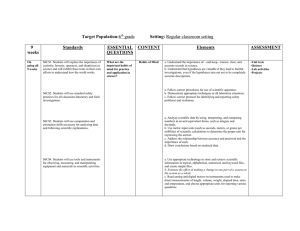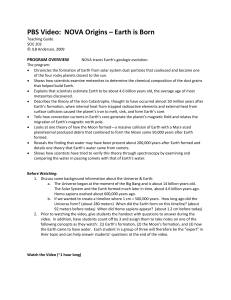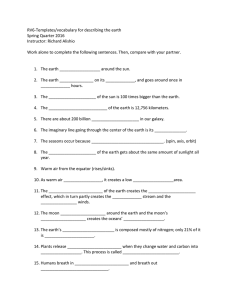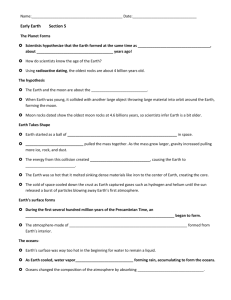Target Population: Setting: 9 week
advertisement
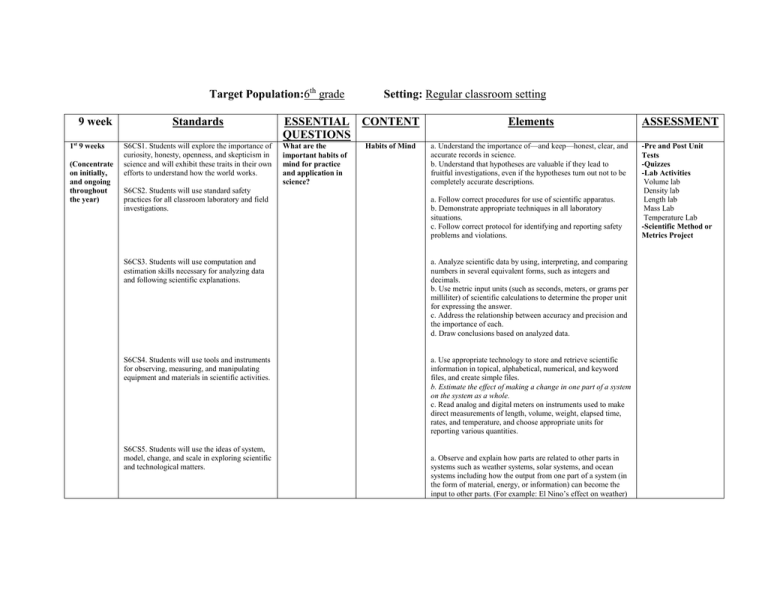
Target Population:6th grade 9 week 1st 9 weeks (Concentrate on initially, and ongoing throughout the year) Standards S6CS1. Students will explore the importance of curiosity, honesty, openness, and skepticism in science and will exhibit these traits in their own efforts to understand how the world works. S6CS2. Students will use standard safety practices for all classroom laboratory and field investigations. Setting: Regular classroom setting ESSENTIAL CONTENT QUESTIONS What are the important habits of mind for practice and application in science? Habits of Mind Elements a. Understand the importance of—and keep—honest, clear, and accurate records in science. b. Understand that hypotheses are valuable if they lead to fruitful investigations, even if the hypotheses turn out not to be completely accurate descriptions. a. Follow correct procedures for use of scientific apparatus. b. Demonstrate appropriate techniques in all laboratory situations. c. Follow correct protocol for identifying and reporting safety problems and violations. S6CS3. Students will use computation and estimation skills necessary for analyzing data and following scientific explanations. a. Analyze scientific data by using, interpreting, and comparing numbers in several equivalent forms, such as integers and decimals. b. Use metric input units (such as seconds, meters, or grams per milliliter) of scientific calculations to determine the proper unit for expressing the answer. c. Address the relationship between accuracy and precision and the importance of each. d. Draw conclusions based on analyzed data. S6CS4. Students will use tools and instruments for observing, measuring, and manipulating equipment and materials in scientific activities. a. Use appropriate technology to store and retrieve scientific information in topical, alphabetical, numerical, and keyword files, and create simple files. b. Estimate the effect of making a change in one part of a system on the system as a whole. c. Read analog and digital meters on instruments used to make direct measurements of length, volume, weight, elapsed time, rates, and temperature, and choose appropriate units for reporting various quantities. S6CS5. Students will use the ideas of system, model, change, and scale in exploring scientific and technological matters. a. Observe and explain how parts are related to other parts in systems such as weather systems, solar systems, and ocean systems including how the output from one part of a system (in the form of material, energy, or information) can become the input to other parts. (For example: El Nino’s effect on weather) ASSESSMENT -Pre and Post Unit Tests -Quizzes -Lab Activities Volume lab Density lab Length lab Mass Lab Temperature Lab -Scientific Method or Metrics Project b. Identify several different models (such as physical replicas, pictures, and analogies) that could be used to represent the same thing, and evaluate their usefulness, taking into account such things as the model’s purpose and complexity. S6CS6. Students will communicate scientific ideas and activities clearly. a. Write clear, step-by-step instructions for conducting scientific investigations, operating a piece of equipment, or following a procedure. b. Understand and describe how writing for scientific purposes is different than writing for literary purposes. c. Organize scientific information using appropriate tables, charts, and graphs, and identify relationships they reveal. S6CS7. Students will question scientific claims and arguments effectively. a. Question claims based on vague attributions (such as “Leading doctors say...”) or on statements made by people outside the area of their particular expertise. b. Recognize that there may be more than one way to interpret a given set of findings. S6CS8. Students will investigate the characteristics of scientific knowledge and how it is achieved. What are the characteristics of scientific knowledge and inquiry and how are they best achieved? The Nature of Science Students will apply the following to scientific concepts: a. When similar investigations give different results, the scientific challenge is to judge whether the differences are trivial or significant, which often requires further study. Even with similar results, scientists may wait until an investigation has been repeated many times before accepting the results as meaningful. b. When new experimental results are inconsistent with an existing, well-established theory, scientists may require further experimentation to decide whether the results are flawed or the theory requires modification. c. As prevailing theories are challenged by new information, scientific knowledge may change and grow. S6CS9. Students will investigate the features of the process of scientific inquiry. Students will apply the following to inquiry learning practices: a. Scientific investigations are conducted for different reasons. They usually involve collecting evidence, reasoning, devising hypotheses, and formulating explanations. b. Scientists often collaborate to design research. To prevent bias, scientists conduct independent studies of the same questions. c. Accurate record keeping, data sharing, and replication of results are essential for maintaining an investigator’s credibility with other scientists and society. d. Scientists use technology and mathematics to enhance the process of scientific inquiry. e. The ethics of science require that special care must be taken and used for human subjects and animals in scientific research. Scientists must adhere to the appropriate rules and guidelines when conducting research. S6E5. Students will investigate the scientific view of how the earth’s surface is formed. Investigate the composition of rocks in terms of minerals. S6E5. What is the scientific view of how the earth’s surface is formed? 2nd Nine weeks Earth’s Composition and Formation (May begin late 1st nine weeks) 3rd Nine -Pre and Post Unit Tests -Quizzes -Lab activities Rock Identification labs Rock Cycle Lab/Project a. Explain that a large portion of the Earth’s surface is water, consisting of oceans, rivers, lakes, underground water, and ice. b. Describe the composition, location, and subsurface topography of the world’s oceans. c. Explain the causes of waves, currents, and tides. S6E3. Students will recognize the significant role of water in earth processes. S6E4. Students will understand how the distribution of land and oceans affects climate and weather. a. Compare and contrast the Earth’s crust, mantle, and core including temperature, density, and composition. b. Classify rocks by their process of formation. c. Describe processes that change rocks and the surface of the earth. d. Recognize that lithospheric plates constantly move and cause major geological events on the earth’s surface. e. Explain the effects of physical processes (plate tectonics, erosion, deposition, volcanic eruption, gravity) on geological features including oceans (composition, currents, and tides). f. Describe how fossils show evidence of the changing surface and climate of the Earth. g. Describe soil as consisting of weathered rocks and decomposed organic material. h. Explain the effects of human activity on the erosion of the earth’s surface. i. Describe methods for conserving resources such as water, soil, and air. What is the significance of water in earth’s processes? a. Demonstrate that land and water absorb and lose heat at different rates and explain the resulting effects on weather patterns. b. Relate unequal heating of land and water surfaces to form large global wind systems and weather events such as tornados and thunderstorms. c. Relate how moisture evaporating from the oceans affects the weather patterns and weather events such as hurricanes. Our World of Water -Pre and Post Unit Tests -Quizzes weeks S6E1. Students will explore current scientific views of the universe and how those views evolved. How do the oceans and land formations affect climate and weather patterns? What are the current scientific theories on how the universe was created and how do they relate to the universe as it is today? 4th 9 weeks Land, Oceans Climate and Weather Current scientific views of the universe a. Relate the Nature of Science to the progression of basic historical scientific theories (geocentric and heliocentric) as they describe our solar system and the Big Bang as it describes the formation of the universe. b. Describe the position of the solar system in the Milky Way galaxy and the universe. c. Compare and contrast the planets in terms of • Size relative to the earth • Surface and atmospheric features • Relative distance from the sun • Ability to support life d. Explain the motion of objects in the day/night sky in terms of relative position. e. Explain that gravity is the force that governs the motion in the solar system. f. Describe the characteristics of comets, asteroids, and meteors. a. Demonstrate the phases of the moon by showing the alignment of the earth, moon, and sun. b. Explain the alignment of the earth, moon, and sun during solar and lunar eclipses. c. Relate the tilt of the earth to the distribution of sunlight throughout the year and its effect on climate. S6E2. Students will understand the effects of the relative positions of the earth, moon and sun. -Lab activities Water Cycle Lab/Demo Coriolis Effect Lab/Demo Current Labs/Demo Heat Lab/Demo Extreme Weather Lab -Pre and Post Unit Tests -Quizzes -Lab activities Astronomy labs (Phases, Big Bang, etc.) -Project Astronomy research project Planet project a. Explain the role of the sun as the major source of energy and its relationship to wind and water energy. b. Identify renewable and nonrenewable resources. S6E6. Students will describe various sources of energy and with their uses and conservation. (Ongoing throughout the year.) What are the effects of the relative positions of the earth, moon and sun? What are the effects of humans on the Positions of the earth, moon and sun Alternate Energy Resource Projects earth and what can they do to protect natural resources? How are various energy sources obtained and used and why is conservation important? Energy: Sources, Uses and Conservation
